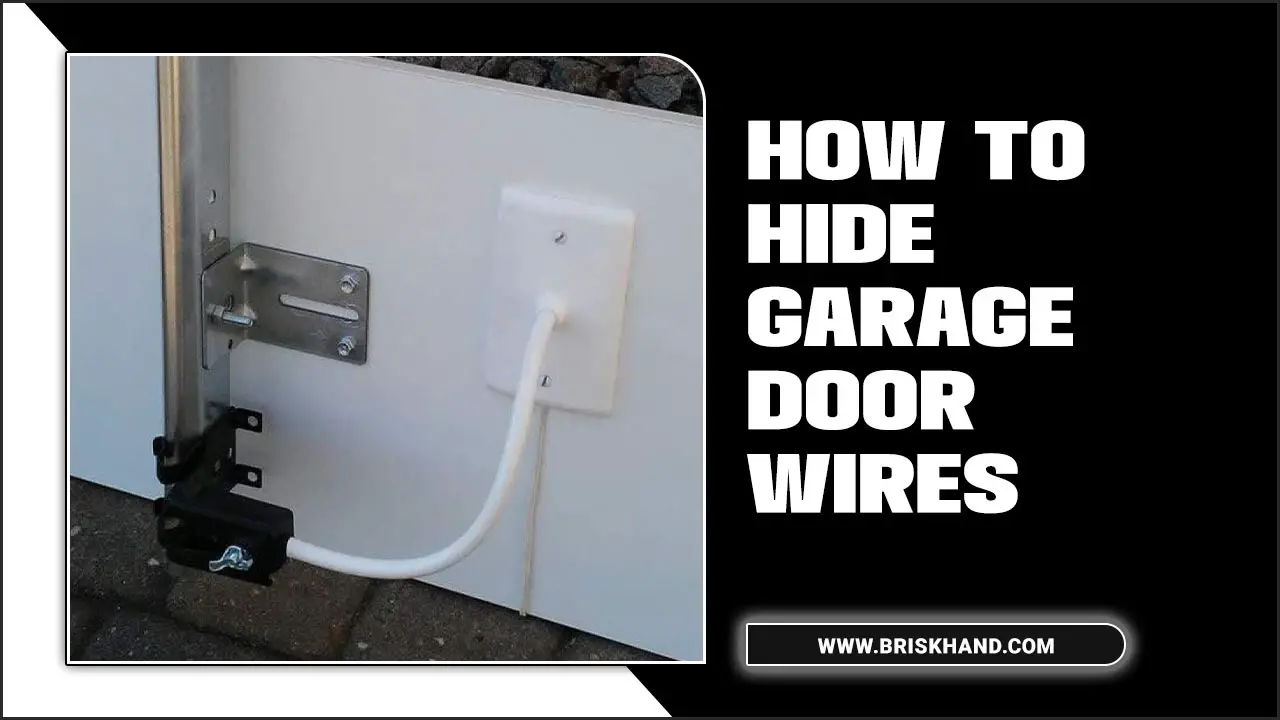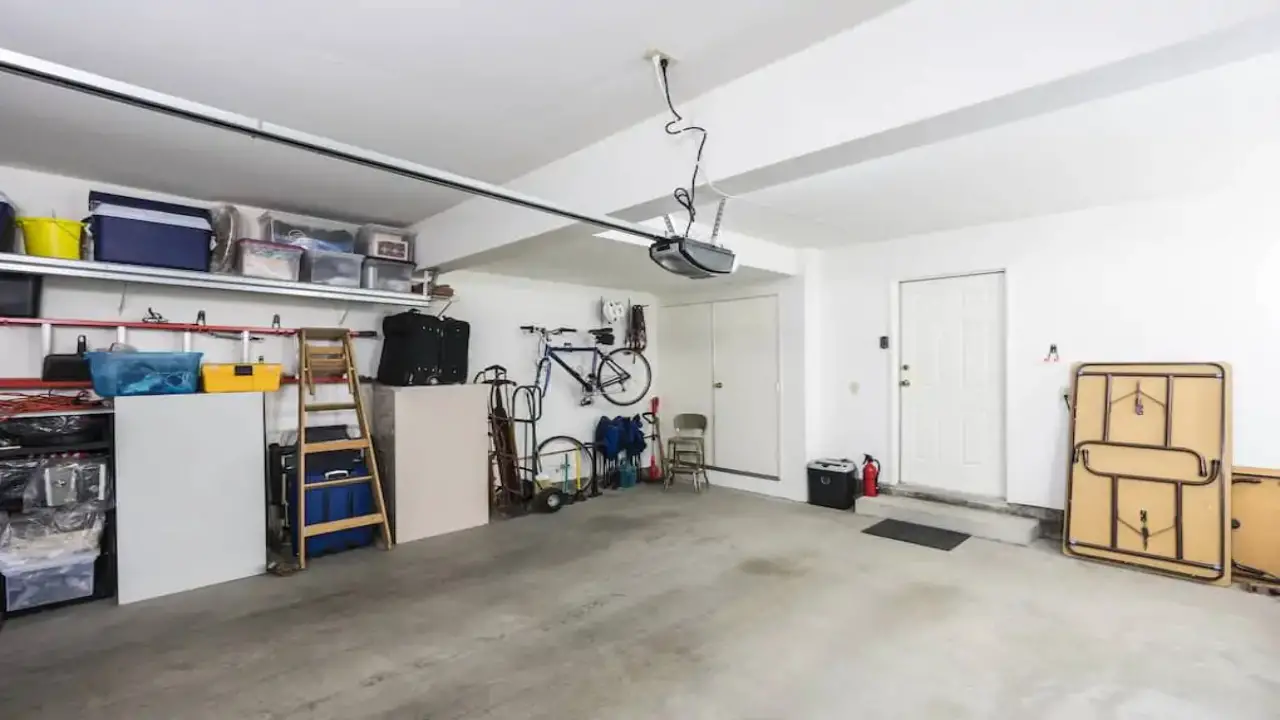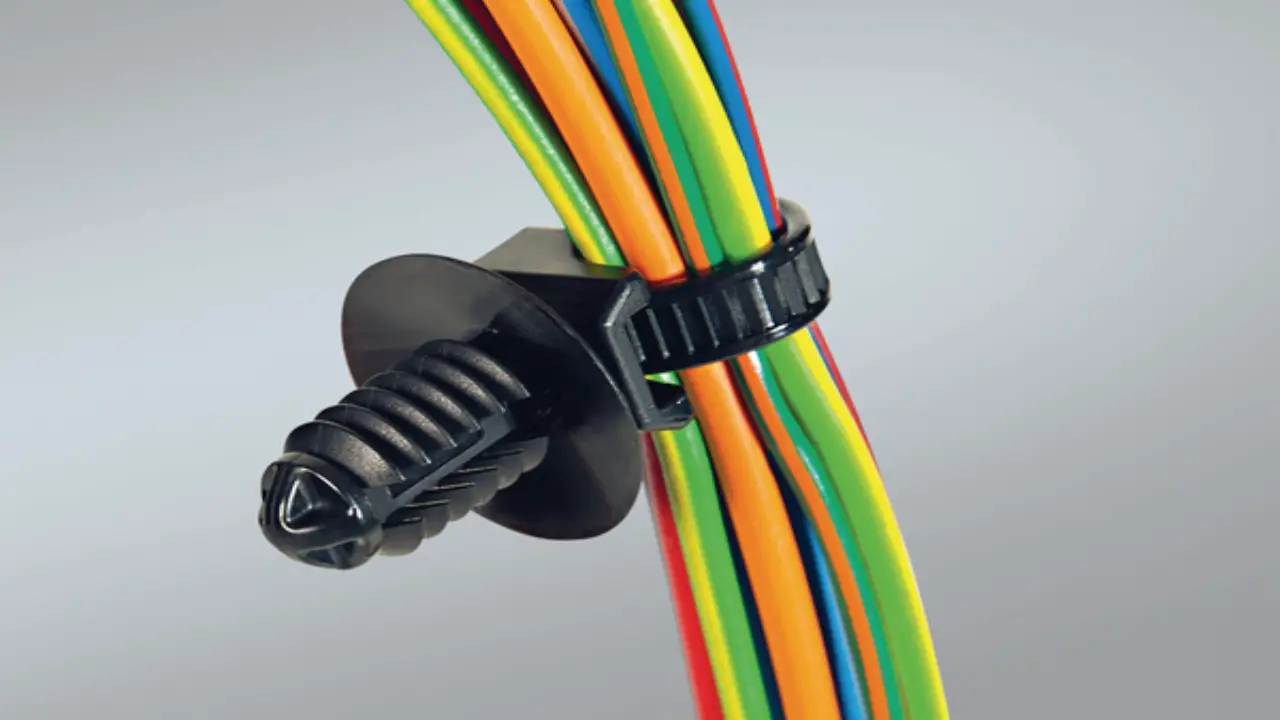Garage doors are essential to any home, providing convenience, safety, and security. However, the wiring that powers the garage door opener can often be unsightly and detract from the overall appearance of your garage.
Hiding garage door wires is a common problem many homeowners face, but the solution is not always obvious. We will explore some simple and effective ways to conceal your garage doorbell wire without compromising safety or functionality.
We will review everything you need about how to hide garage door wires like a pro. The importance of properly installing the essential materials required for concealing power wire and a step-by-step guide to hiding them.
We will also provide some tips and tricks for making the job easier, discuss whether it is necessary to hire a professional, and what costs you should expect. Say goodbye to those unsightly wires and hello to a safer, cleaner-looking garage.

Why Should You Hide Garage Door Wires?

Enhance the safety and appearance of your garage by hiding the garage door wires. Concealing them prevents accidental contact, reducing the risk of electrical hazards. Additionally, hidden wires create a seamless look and improve the overall aesthetics of your garage.
- Safety: Hiding garage door wires helps prevent accidents and injuries by eliminating potential tripping hazards.
- Aesthetics: Concealing the wires improves the overall appearance of the garage, creating a cleaner and more organized look.
- Protection From Damage: Exposed garage door wires are susceptible to damage from weather elements, pests, and accidental tugging. Hiding them ensures their longevity and proper functioning.
- Enhanced Security: Concealed wires make it harder for potential intruders to tamper with the garage door system, adding an extra layer of security to your home.
- Compliance With Building Codes: In some areas, local building codes may require hiding garage door wires for safety and aesthetic reasons.
Essential Materials For Hiding Garage Door Wires
Use wire moulding and adhesive tape to achieve a seamless, concealed look. Protect the wires from external elements by using low-voltage tubing and conduit.
By choosing suitable materials, you can ensure a secure and long-lasting wire-hiding solution. These tools allow you to remove the outer insulation from the wires, exposing the inner conductive material. Here are some essential tools that you will need for this project:
- Wire cutters
- Wire strippers
- Electrical tape
- Cable clips
- Screwdriver or drill
Step-By-Step Guide How To Hide Garage Door Wires

When installing a garage door opener, it’s essential to identify the power source and determine the best way to conceal wires. Cable clips or conduits can help secure the wires and prevent them from getting tangled or damaged. Consider using a power bridge kit or outlet for a neat appearance.
Testing the opener after installation is also crucial to ensure it functions correctly. By following these steps, you can successfully install a garage door opener while maintaining a clean and organized look in your garage. Here are step-by-step processes on how to hide garage door wires.
Step 1: Measuring The Area

To begin hiding garage door wires, start by measuring the length of the cables and the distance from the garage door opener to the nearest outlet. Consider the path the wires will take, avoiding obstacles and sharp bends. Determine the ideal location for junction boxes or splices, and think about using conduit or wire molding to conceal the wires and protect them.
Step 2: Choosing The Right Concealer
Regarding concealing wires in your garage, there are several factors to consider. Firstly, consider the wire location and surface type, as different concealment methods work better for other areas. Secondly, it is essential to match the color and style of the concealer to your garage door so that it blends in seamlessly.
In addition, choosing a durable and weather-resistant material is crucial to ensure the concealer can withstand harsh outdoor conditions. Finally, you must decide on the best installation method for your needs – adhesive or screws are two standard options.
Step 3: Preparing The Material
Before you begin the process, gather all the necessary materials. You will need wire clips or cable management solutions, a power drill with a masonry bit, and a caulk gun with exterior-grade caulk. It’s important to choose wire clips or cable management solutions that are suitable for outdoor use and can withstand the elements.
Additionally, make sure to measure the length of the wire and determine how many clips or cable management solutions you will need. Once you have all your materials ready, you can move on to the next step of hiding your garage door wires.
Step 4: Installing The Concealer
Installing a wire concealer is a great way to hide garage door wires and keep them neatly tucked away. Here are the steps to install a wire concealer. By following these steps, you can easily hide your garage door wires and create a cleaner and more organized look in your garage.
- Measure and cut the wire concealer to the desired length using a saw or utility knife.
- Attach the adhesive backing to one side of the wire concealer, making sure it is secure.
- Position the wire concealer along the desired path of the garage door wires, ensuring it is straight and level.
- Press firmly on the adhesive side of the wire concealer to secure it in place.
- Use screws or nails to further secure the wire concealer if necessary.
- Carefully thread the garage door wires through the open channel of the wire concealer, ensuring they are hidden from view.
- Once all wires are in place, press down on the cover of the wire concealer to close it securely.
Step 5: Securing The Wires

To ensure the proper organization of the garage door wires, utilize cable ties. Adhesive clips can securely fasten the cables to the garage door tracks or walls.
Protect and conceal the wires by using a cable cover. Leave enough slack in the wires to accommodate the garage door’s movement. Finally, conduct a test to verify that the cables are securely installed and do not interfere with the garage door’s operation.
Step 6: Checking The Connection
Once the wires are securely in place, power on the garage door opener to check the connection and ensure no loose or exposed wires. If everything looks good, turn off the power and replace the cover on the garage door opener. Enjoy your newly concealed garage door wires!
One option is to utilize wire concealment techniques. By utilizing cable raceways or wire molding, you can neatly disguise the wires along the walls or ceiling of your garage. These solutions provide a professional and seamless appearance while ensuring the wires are securely hidden.
Step 7: Finishing Up
To finish hiding garage door wires, conceal them behind wire molding or conduit. Paint the cover to match the wall or ceiling. Test the opener for proper functionality, secure loose cables, and tidy the workspace.
Enjoy a clean and organized garage with hidden wires. Finally, test the garage door operation after hiding the lines to ensure everything works properly. With these finishing touches, your garage door wires will be neatly concealed, enhancing the overall appearance of your space.
Precautions Before You Start
Before starting the process of hiding garage door wires, it is crucial to disconnect the power source to ensure safety. Additionally, checking for damaged wires beforehand helps identify potential issues that may arise during the concealment process. These precautions minimize the risk of accidents or damage.
- Ensure that the power to the garage door opener is turned off before starting any work on hiding the wires.
- Use appropriate safety equipment, such as gloves and safety goggles, to protect yourself from hazards.
- Carefully inspect the area where the wires are located to identify potential obstacles or hazards that may interfere with the hiding process.
- Plan out the route for the wires to be hidden, considering any obstacles or obstructions that may need to be navigated around.
- Use cable management solutions such as wire clips or conduits to secure and protect the wires, ensuring they are not exposed to potential damage or interference.
- Avoid running the wires along any sharp or abrasive surfaces that may cause damage to the insulation or expose the wires.
- Test the garage door opener after hiding the wires to ensure that it is functioning properly and that there are no issues with the wiring.
- Consult a professional electrician if you are unsure about hiding the garage door wires.
Importance Of Proper Wire Installation

Proper wiring installation for garage doors ensures smooth functionality and minimizes safety hazards. Professional installation guarantees optimal performance and reliability. Incorrect installation can lead to malfunctions, posing risks to property and individuals. Safeguard your garage by prioritizing proper wire installation.
An exposed garage door sensor wire can pose electrical and safety risks. Unprotected cables are susceptible to damage and accidents. Additionally, they can be an eyesore and disrupt the garage’s aesthetics. It is essential to address these risks for a safer and visually appealing garage.
Pros And Cons Of Hiring A Professional
Hiring a professional to hide garage door wires can save time and ensure a neat and safe installation. They have the necessary tools and expertise to hide wires in challenging areas. However, DIY methods may save money but might not be as efficient or aesthetically pleasing. Consider potential risks and research professionals before making a decision.
Pros
- Enhanced aesthetics
- Reduced risk of damage
- Increased safety
- Enhanced functionality
Cons
- Increased installation complexity
- Limited accessibility for maintenance and repairs
Costs Associated With Hiding Garage Door Wires
The costs of hiding garage door wires can vary depending on the job’s complexity. Hiring a professional can range from $200 to $500, while DIY options are available to save money, although they may require additional tools and materials. The benefits of hiding garage door wires include improved safety and aesthetics.
How To Hide Wires With Cord Covers
Knowing how to hide wires with cord covers is important for several reasons. It helps to maintain a visually appealing environment. Whether it is a home office, living room, or entertainment area, a neat and clutter-free space enhances the overall ambience and makes a positive impression on anyone who enters.
Additionally, cord covers eliminate potential tripping hazards, reducing the risk of accidents or injuries.
- Measure the length of the wires you want to hide to determine the size and quantity of cord covers needed.
- Purchase cord covers that match the color and style of your room decor.
- Disconnect and unplug all electrical devices to ensure safety.
- Remove any existing cable clips or ties from the wires.
- Open the cord cover and place the wires inside, ensuring they are neatly arranged.
- Close the cord cover securely, making sure all wires are fully enclosed.
- Use adhesive tape or mounting brackets to secure the cord cover to the wall or baseboard.
- Trim the cord cover to fit the desired length using a utility knife or scissors.
- Reconnect and plug in all electrical devices once the cord covers are installed.
- Tuck any excess wire length behind furniture or use cable management solutions to keep them organized and hidden.
- Regularly check the cord covers for any damage or wear and replace them if necessary.
How To Create A Charging Station

A charging station allows individuals to keep their devices powered up and ready. Whether it is a smartphone, tablet, or laptop, these devices have become integral to our daily lives for personal and professional purposes. Individuals can conveniently charge their devices in a central location by creating a charging station, ensuring they are always accessible and ready for use.
- Determine the purpose and location of the charging station.
- Assess the power requirements based on the devices that will be charged.
- Choose a suitable power source, such as a wall outlet or a dedicated electrical circuit.
- Select a charging station design or build one according to your needs and preferences.
- Ensure the charging station has enough outlets and ports to accommodate multiple devices simultaneously.
- Install the necessary electrical components, such as sockets, USB ports, or wireless charging pads.
- Consider incorporating cable management solutions to organise the charging area and minimize clutter.
- Test the charging station to ensure it is functioning properly and safely.
- Make any necessary adjustments or improvements based on user feedback and usage patterns.
- Regularly maintain and clean the charging station to ensure its longevity and optimal performance.
Conclusion
Hiding garage door wires improves your space’s safety and enhances your garage’s overall appearance and cleanliness. Exposed wires can pose potential risks and may lead to accidents or damage to the wires themselves. You can easily hide the wires by following a step-by-step guide on how to hide garage door wires and using essential materials such as wire concealers and cord covers.
Additionally, you can incorporate tips and tricks like crown molding or creating a charging station to improve the aesthetics further. While hiring a professional is an option, it is not always necessary, as hiding garage door wires can be a DIY project.
Consider the pros and cons and the associated costs before making a decision. Remember, you can hide other wires in your garage to achieve a clutter-free and organized space.
Frequently Asked Questions
What Is The Alternative To Plastic Trunking?
One alternative to plastic trunking is using metal or aluminum trunking. These materials are more durable and can withstand higher temperatures, making them suitable for industrial or outdoor applications.
Can I Block My Garage Door?
You can block your garage door by placing an obstacle or object before it to prevent it from opening or closing. However, it is important to note that blocking your garage door can be a safety hazard and may damage the door or the mechanism.
What Blocks Garage Door Frequency?
Several factors can block garage door frequency, including physical obstacles such as walls or large objects obstructing the signal, electromagnetic interference from nearby electronic devices, or even a malfunctioning garage door opener or receiver.
What Can Block Garage Door Opener Signal?
Various factors can block a garage door opener signal, including physical obstructions like walls or objects in the signal’s path, electrical interference from nearby devices or appliances, and signal jamming from other wireless devices operating on the same frequency.
Can Electrical Wire Be Exposed In The Garage?
No, electrical wires should not be exposed in a garage. It is important to follow proper electrical safety guidelines and regulations, which typically require wires to be properly insulated and protected to prevent the risk of electrical shock or fire hazards.

I am passionate about tools and electric work. I love finding new tools and experimenting with them.

